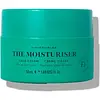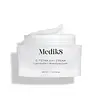What's inside
What's inside
 Key Ingredients
Key Ingredients

 Benefits
Benefits

 Concerns
Concerns

 Ingredients Side-by-side
Ingredients Side-by-side

Water
Skin ConditioningPropanediol
SolventPolyglyceryl-3 Cetearyl Ether Olivate
EmulsifyingGlycerin
HumectantCanola Oil
EmollientCetearyl Alcohol
EmollientSqualane
EmollientJojoba Oil/Macadamia Seed Oil Esters
Skin ConditioningCaprylic/Capric Triglyceride
MaskingDimethicone
EmollientOctyldodecanol
EmollientFructooligosaccharides
HumectantOctyldodecyl PCA
EmollientBeta Vulgaris Root Extract
Skin ConditioningTerminalia Ferdinandiana Fruit Extract
AntioxidantPodocarpus Elatus Fruit Extract
Skin ConditioningPleiogynium Timoriense Fruit Extract
Skin ConditioningPhenoxyethanol
PreservativeCarbomer
Emulsion StabilisingSqualene
EmollientHydroxyacetophenone
Antioxidant7-Dehydrocholesterol
Emulsion StabilisingPotassium Lactate
BufferingSodium Gluconate
Skin ConditioningDimethicone/Vinyl Dimethicone Crosspolymer
Skin ConditioningEthylparaben
PreservativeMethylparaben
PreservativeSodium Hydroxide
BufferingButylene Glycol
HumectantLactic Acid
BufferingPhytosteryl Macadamiate
Skin ConditioningTocopherol
AntioxidantSodium Hyaluronate
Humectant1,2-Hexanediol
Skin ConditioningCeramide NP
Skin ConditioningPhytosterols
Skin ConditioningWater, Propanediol, Polyglyceryl-3 Cetearyl Ether Olivate, Glycerin, Canola Oil, Cetearyl Alcohol, Squalane, Jojoba Oil/Macadamia Seed Oil Esters, Caprylic/Capric Triglyceride, Dimethicone, Octyldodecanol, Fructooligosaccharides, Octyldodecyl PCA, Beta Vulgaris Root Extract, Terminalia Ferdinandiana Fruit Extract, Podocarpus Elatus Fruit Extract, Pleiogynium Timoriense Fruit Extract, Phenoxyethanol, Carbomer, Squalene, Hydroxyacetophenone, 7-Dehydrocholesterol, Potassium Lactate, Sodium Gluconate, Dimethicone/Vinyl Dimethicone Crosspolymer, Ethylparaben, Methylparaben, Sodium Hydroxide, Butylene Glycol, Lactic Acid, Phytosteryl Macadamiate, Tocopherol, Sodium Hyaluronate, 1,2-Hexanediol, Ceramide NP, Phytosterols
Water
Skin ConditioningHeptyl Undecylenate
EmollientCaprylic/Capric Triglyceride
MaskingTetrahexyldecyl Ascorbate
AntioxidantMethylpropanediol
SolventCetearyl Olivate
Cetearyl Isononanoate
EmollientDistarch Phosphate
AbsorbentTocopheryl Acetate
AntioxidantSodium Polyacrylate
AbsorbentSorbitan Olivate
EmulsifyingSodium Hyaluronate
HumectantCaprylyl Glycol
EmollientGlycerin
HumectantDisodium EDTA
Phenylpropanol
MaskingCitrus Grandis Peel Oil
MaskingCitrus Limon Peel Oil
MaskingCitrus Aurantium Bergamia Fruit Oil
MaskingPelargonium Graveolens Flower Oil
MaskingSodium Hydroxide
BufferingLimonene
PerfumingCitronellol
PerfumingLinalool
PerfumingGeraniol
PerfumingCitral
PerfumingWater, Heptyl Undecylenate, Caprylic/Capric Triglyceride, Tetrahexyldecyl Ascorbate, Methylpropanediol, Cetearyl Olivate, Cetearyl Isononanoate, Distarch Phosphate, Tocopheryl Acetate, Sodium Polyacrylate, Sorbitan Olivate, Sodium Hyaluronate, Caprylyl Glycol, Glycerin, Disodium EDTA, Phenylpropanol, Citrus Grandis Peel Oil, Citrus Limon Peel Oil, Citrus Aurantium Bergamia Fruit Oil, Pelargonium Graveolens Flower Oil, Sodium Hydroxide, Limonene, Citronellol, Linalool, Geraniol, Citral
Ingredients Explained
These ingredients are found in both products.
Ingredients higher up in an ingredient list are typically present in a larger amount.
This ingredient is an emollient, solvent, and texture enhancer. It is considered a skin-softener by helping the skin prevent moisture loss.
It helps thicken a product's formula and makes it easier to spread by dissolving clumping compounds.
Caprylic Triglyceride is made by combining glycerin with coconut oil, forming a clear liquid.
While there is an assumption Caprylic Triglyceride can clog pores due to it being derived from coconut oil, there is no research supporting this.
Learn more about Caprylic/Capric TriglycerideGlycerin is already naturally found in your skin. It helps moisturize and protect your skin.
A study from 2016 found glycerin to be more effective as a humectant than AHAs and hyaluronic acid.
As a humectant, it helps the skin stay hydrated by pulling moisture to your skin. The low molecular weight of glycerin allows it to pull moisture into the deeper layers of your skin.
Hydrated skin improves your skin barrier; Your skin barrier helps protect against irritants and bacteria.
Glycerin has also been found to have antimicrobial and antiviral properties. Due to these properties, glycerin is often used in wound and burn treatments.
In cosmetics, glycerin is usually derived from plants such as soybean or palm. However, it can also be sourced from animals, such as tallow or animal fat.
This ingredient is organic, colorless, odorless, and non-toxic.
Glycerin is the name for this ingredient in American English. British English uses Glycerol/Glycerine.
Learn more about GlycerinSodium Hyaluronate is hyaluronic acid's salt form. It is commonly derived from the sodium salt of hyaluronic acid.
Like hyaluronic acid, it is great at holding water and acts as a humectant. This makes it a great skin hydrating ingredient.
Sodium Hyaluronate is naturally occurring in our bodies and is mostly found in eye fluid and joints.
These are some other common types of Hyaluronic Acid:
Learn more about Sodium HyaluronateSodium Hydroxide is also known as lye or caustic soda. It is used to adjust the pH of products; many ingredients require a specific pH to be effective.
In small amounts, sodium hydroxide is considered safe to use. However, large amounts may cause chemical burns due to its high alkaline.
Your skin has a natural pH and acid mantle. This acid mantle helps prevent harmful bacteria from breaking through. The acid mantle also helps keep your skin hydrated.
"Alkaline" refers to a high pH level. A low pH level would be considered acidic.
Learn more about Sodium HydroxideWater. It's the most common cosmetic ingredient of all. You'll usually see it at the top of ingredient lists, meaning that it makes up the largest part of the product.
So why is it so popular? Water most often acts as a solvent - this means that it helps dissolve other ingredients into the formulation.
You'll also recognize water as that liquid we all need to stay alive. If you see this, drink a glass of water. Stay hydrated!
Learn more about Water